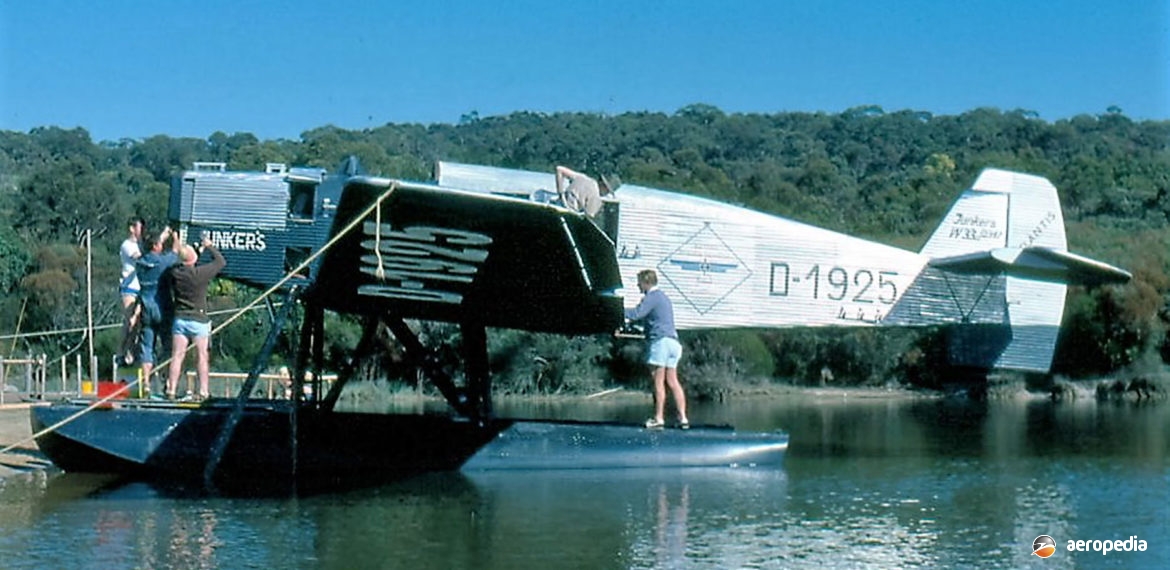Photograph:
Built for a television series, replica of Junkers W 33 D-1925 at Manly, NSW in 1984 (Eric S Favelle)
Country of origin:
Germany
Description:
General-purpose commercial transport
Power Plant:
One 231 kw (310 hp) Junkers L5 six-cylinder upright in-line liquid-cooled engine
Specifications:
- Wingspan: 17.74 m (58 ft 2¾ in)
- Length: 10.5 m (34 ft 5½ in)
- Height: 3.53 m (11 ft 7 in)
- Wing area: 43 m² (463 sq ft)
- Max speed: 197 km/h (122 mph)
- Cruising speed: 150 km/h (93 mph)
- Absolute ceiling: 4,298 m (14,100 ft)
- Time to climb to 1,000 m (3,281 ft): 4.5 mins
- Time to climb to 2,000 m (6.562 ft): 9.5 mins
- Range: 1,000 km (621 miles)
- Empty weight: 1,217 kg (2,689 lb)
- Useful load: 408 kg (900 lb)
- Loaded weight: 2,494 kg (5,511 lb)
History:
The W 33 was developed by Junkers concurrently with the W 34 series, both being virtually identical, and in the ultimate a development of the F 13. Production took place from 1927 to 1934 and 199 examples were produced.
The prototype for the series (D-922) was powered by a 313 kw (420 hp) Gnome Rhone Jupiter VI engine and was fitted with floats. Production aircraft had the Junkers L5 engine, a crew of two, and could carry six passengers. Construction was all-metal, with duralumin skinning.
W 33 variants approached the 30 mark, including the W 33B, W 33-c, W 33-dd, W 33-f, etc, most with the Junkers L5 engine but some with the L5G engine of 254 kw (340 hp). At least one had the 403 kw (540 hp) Siemens Sh20 radial installed.
Most W 33s were used as freighters or mail carriers, and four saw service with Luft Hansa from 1929. Others saw service in the crop-spraying and aerial-survey roles, and a few survived to see service with the Luftwaffe during World War II as communications aircraft and trainers.
The type was in widespread service with airlines in the 1930s, operating in countries such as Germany, China, and Canada, many operating as freighters or mail carriers with the windows removed and covered over. The type inaugurated Luft Hansa’s first regular mail schedules, a fleet of four being used from 1929.
One W 33, flown by Messrs Ristig and Zimmermann, established a world endurance record on 3 to 5 August 1927 of 52 hrs 23 mins; and another (D-1167 – ‘Bremen’) flew non-stop across the Atlantic east-to-west on 12 and 13 April 1928 from Baldonnel near Dublin to Greenly Island off Labrador in a time of 37 hours. One, flown by Willy Neunhofen, achieved an altitude record of 12,741 m (41,800 ft) on 26 May 1929.
One W 33 saw service in Australia (although five W 34s were also registered), this being VH-UIW (c/n 2575), built at Dessau in 1929. It was imported by Messrs J S Taylor and G S Bond and was assembled at Point Cook, VIC in February 1930. It was fitted with floats at that stage, these being needed to fly it in stages to Papua New Guinea as suitable aerodromes for refuelling stops were not available. It flew up the east coast of Australia and on arrival at Salamaua reverted to landplane configuration, entering service with Pacific Aerial Transport Ltd of Wau with the name “Lady Lettie”. Its pilots are known to have included Papua New Guinea identities Raymond and Kevin Parer. After a couple of accidents it was acquired by Mandated Airlines Ltd of Salamaua in October 1936 for overhaul but the work was not completed. The fuselage was salvaged during 1987 from the jungle at Alexishafen for a museum in Port Moresby but as yet has not been restored.
One example (D-1925) gained notoriety in 1932 when, on a night flight over the Timor Sea, having left Soerabaja in the Dutch East Indies for Darwin, NT, it became lost in a storm, ran out of fuel and landed on the Western Australian coast in the Kimberleys, its German crew, Hans Bertram and Adolph Klausmann missing for 53 days. Eventually they were located by aboriginals and taken to safety. The crew, and the aircraft when recovered, returned to Germany.
In 1985 the Australian Broadcasting Corporation (ABC) made a television mini-series about this epic called “Flight into Hell” and a full-scale non-flying replica of the W 33 was built at the ABC studios at Frenchs Forest, NSW, fitted with a Jaguar six-cylinder motor-car engine. The floats were built of fibreglass and the aircraft of all-wood construction with metal covering. It was completed in August 1984 and was able to taxi at reasonable speed on Manly Lake for filming. The replica was subsequently obtained and placed on display in the museum of the Royal Australian Air Force (RAAF) Association in Perth, WA, alongside one of the floats of the original aircraft.
In October 2008 the replica was acquired by the Australian Aviation Museum at Bankstown, NSW and was to be conveyed to Camden, NSW where it was to be placed in storage pending the museum being moved from Bankstown to Camden in 2011. However, the museum was not moved and the replica aircraft was noted stored in the open for a period but is believed to have been scrapped.

